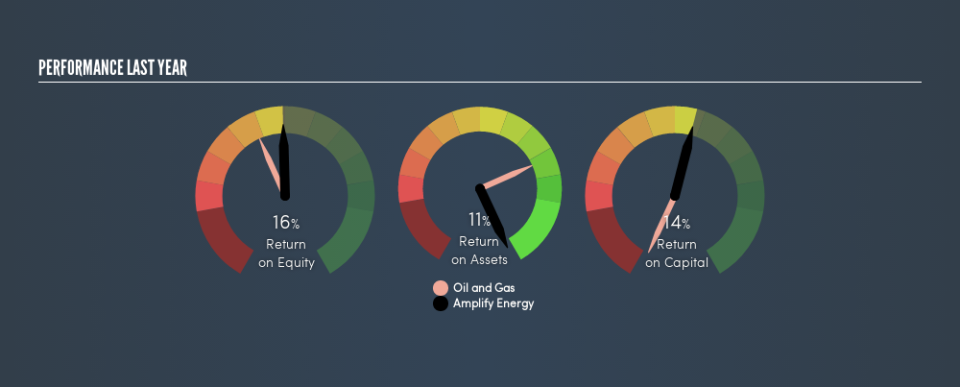What Can We Make Of Amplify Energy Corp.’s (NYSE:AMPY) High Return On Capital?

Today we are going to look at Amplify Energy Corp. (NYSE:AMPY) to see whether it might be an attractive investment prospect. Specifically, we're going to calculate its Return On Capital Employed (ROCE), in the hopes of getting some insight into the business.
First of all, we'll work out how to calculate ROCE. Then we'll compare its ROCE to similar companies. Then we'll determine how its current liabilities are affecting its ROCE.
Understanding Return On Capital Employed (ROCE)
ROCE measures the 'return' (pre-tax profit) a company generates from capital employed in its business. All else being equal, a better business will have a higher ROCE. In brief, it is a useful tool, but it is not without drawbacks. Author Edwin Whiting says to be careful when comparing the ROCE of different businesses, since 'No two businesses are exactly alike.'
So, How Do We Calculate ROCE?
Analysts use this formula to calculate return on capital employed:
Return on Capital Employed = Earnings Before Interest and Tax (EBIT) ÷ (Total Assets - Current Liabilities)
Or for Amplify Energy:
0.14 = US$91m ÷ (US$723m - US$61m) (Based on the trailing twelve months to June 2019.)
Therefore, Amplify Energy has an ROCE of 14%.
View our latest analysis for Amplify Energy
Is Amplify Energy's ROCE Good?
ROCE can be useful when making comparisons, such as between similar companies. Using our data, we find that Amplify Energy's ROCE is meaningfully better than the 7.9% average in the Oil and Gas industry. I think that's good to see, since it implies the company is better than other companies at making the most of its capital. Independently of how Amplify Energy compares to its industry, its ROCE in absolute terms appears decent, and the company may be worthy of closer investigation.
Amplify Energy has an ROCE of 14%, but it didn't have an ROCE 3 years ago, since it was unprofitable. This makes us wonder if the company is improving. You can see in the image below how Amplify Energy's ROCE compares to its industry. Click to see more on past growth.
Remember that this metric is backwards looking - it shows what has happened in the past, and does not accurately predict the future. Companies in cyclical industries can be difficult to understand using ROCE, as returns typically look high during boom times, and low during busts. ROCE is, after all, simply a snap shot of a single year. Given the industry it operates in, Amplify Energy could be considered cyclical. You can check if Amplify Energy has cyclical profits by looking at this free graph of past earnings, revenue and cash flow.
What Are Current Liabilities, And How Do They Affect Amplify Energy's ROCE?
Current liabilities include invoices, such as supplier payments, short-term debt, or a tax bill, that need to be paid within 12 months. Due to the way the ROCE equation works, having large bills due in the near term can make it look as though a company has less capital employed, and thus a higher ROCE than usual. To check the impact of this, we calculate if a company has high current liabilities relative to its total assets.
Amplify Energy has total assets of US$723m and current liabilities of US$61m. Therefore its current liabilities are equivalent to approximately 8.4% of its total assets. Low current liabilities have only a minimal impact on Amplify Energy's ROCE, making its decent returns more credible.
Our Take On Amplify Energy's ROCE
If Amplify Energy can continue reinvesting in its business, it could be an attractive prospect. There might be better investments than Amplify Energy out there, but you will have to work hard to find them . These promising businesses with rapidly growing earnings might be right up your alley.
If you are like me, then you will not want to miss this free list of growing companies that insiders are buying.
We aim to bring you long-term focused research analysis driven by fundamental data. Note that our analysis may not factor in the latest price-sensitive company announcements or qualitative material.
If you spot an error that warrants correction, please contact the editor at editorial-team@simplywallst.com. This article by Simply Wall St is general in nature. It does not constitute a recommendation to buy or sell any stock, and does not take account of your objectives, or your financial situation. Simply Wall St has no position in the stocks mentioned. Thank you for reading.

 Yahoo Finance
Yahoo Finance 
